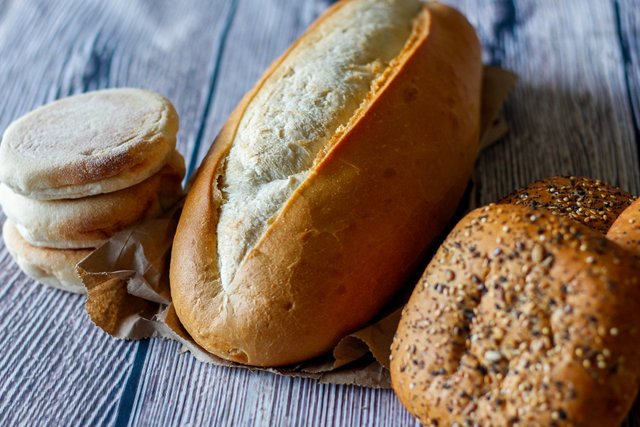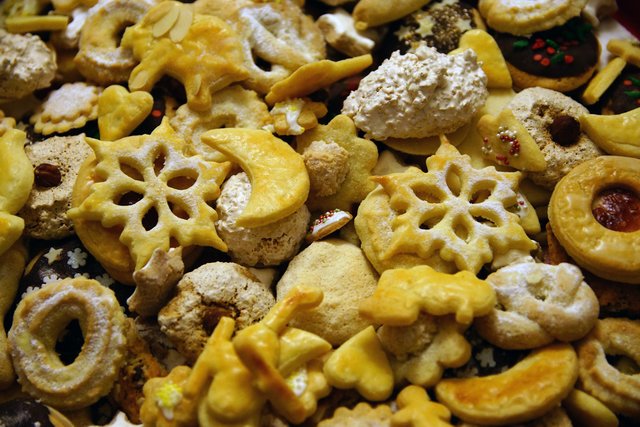The pan and the science – leavening agents
One of the most common physicochemical phenomena in the kitchen is the leavening of the dough.

Leavening agents are those substances that release gases and cause the risen of dough during baking or frying.
To understand how the dough is rising, we need to understand what happens when flour is mixed with liquid ingredients.
Wheat flour contains besides starch two proteins: gliadin and glutenin. During the kneading, in the presence of water, these two will form the gluten and this it is responsible for the elastic structure of the dough.
The gas bubbles formed by the leavening agent remain trapped in the gluten structure and as the temperature rises during the baking process, they increase the volume. When the temperature rises, even more, the gluten coagulates, the starch becomes gelatinized and form the fluffy structure characteristic to pastry and bakery products.
The gluten coagulates starting about 38°C but finishes to coagulate between 70°C and 80°C.
In dough without gluten (or not kneaded), such as those based on whipped egg whites, the protein structure is formed on the base of egg albumin.
The egg white coagulates between 60°C and 65° C.
Although essentially the mode of action is the same, the expansion of a gas that causes the rise of dough, the leavening agents are divided into three main categories:
- Physical leavening agents – air, steam – are generally used in pastry and confectionery
- Chemical leavening agents – sodium bicarbonate (baking soda and baking powder) and ammonium bicarbonate – are often used in cakes and biscuits production
- Biological – yeasts – used mainly for bread production
Physical leavening agents
Air
It is the simplest leavening agent. The typical dough is that based on whipped egg whites.It is generally used in chiffon cakes and sponge cakes and it is still met in the case of flat, unleavened bread.
Up to a point we can talk about an isobar transformation.

Vf - Final volume
Ti - Initial temperature (°K)
Tf - Final temperature (°K)
When the dough water begins to evaporate and the mass of gas increases, the volume increases even more.
Steam
It is used where the baking temperature is high, and the dough is elastic enough to hold the steam until the gluten or albumin coagulates - Yorkshire puddings, choux, pastry.
1 mol of water = 18.0152 g = 30.6 liters of water vapor at 100° C.
Then we are also talking about an isobar transformation.

Chemical leavenings
These are inorganic chemical compounds which, under certain conditions, release large amounts of carbon dioxide or carbon dioxide and ammonia.
Sodium bicarbonate (NaHCO3)
It is especially used for the preparation of cakes or biscuits, but also for soda bread.
At temperatures above 65°C, sodium bicarbonate decomposes and forms carbon dioxide.
The chemical reaction is as follows:
Considering the coagulation temperatures of gluten and egg whites, we need to have carbon dioxide in the dough at temperatures lower than that at which sodium bicarbonate begins to decompose.

The reaction of sodium bicarbonate with acids is used for this. Citric acid, tartaric acid, vinegar, lemon juice, fruit juice, etc. are commonly used.
Sodium bicarbonate reacts with acid (acetic in the equation below) as follows:
In fact, the reaction has two phases.
The first phase results in sodium acetate and carbonic acid.
And then the carbonic acid decomposes into water and carbon dioxide.
The reaction is similar to other acids.
Baking powder
It is a mixture of sodium bicarbonate, citric acid or tartaric acid and starch. When mixed in a dough, the reaction above starts.
Double action baking powder has two or more acids, one reacts at room temperature, while the other react only when it is heated.
Ammonium bicarbonate
It is used less and less because of the irritating effect of ammonia on the respiratory system.
It is the ammonium salt of carbonic acid.
By heating them to above 36°C decomposes according to the reaction below:
Biological leavenings
Last but not least – Yeasts
The most used and most important leavening agents are yeasts.
Yeasts are unicellular microorganisms in the fungus class.
The most important yeast for dough leavening is Saccharomyces cerevisiae.
Yeast breaks down sugars in two ways:
- Aerobic, they decompose the sugars in carbon dioxide and water
- Anaerobic - they decompose the sugars in ethanol and carbon dioxide
If you didn't know, now you know how the dough rise!


Alătură-te serverului Discord!
Posted from my blog with SteemPress : http://www.dictionarculinar.ro/the-pan-and-the-science-leavening-agents/
Very impressive! I follow some recipes that have worked well for me in the past and have my own starter that I use for my sourdough and I usually make sourdough because I like it the most. It's great to see all the scientific means behind it.
I also use the sourdough starter when I make bread. The taste is much better and the texture is dense. Since I knew I preferred brown bread, with a thick crust, made of brown wheaten flour. For donuts and cozonac, I prefer yeast.
I salivated on your dishes a few times and those of @missdeli.
I really am interested in deliveries though overseas food delivery business might not be all that efficient.
I can't agree with you more, it seems that the field of cooking has little modern scientific tricks up its sleeve.
I am a great fan of cooking with science, although I usually do no cooking :D
It seems like a great area to explore and a very good marketing idea. I remember eating in a lot of places especially because they were marketed like this, in Spain, Portugal and France.
Never ate "with science" in Romania, I am sure we have some places so you gave me an idea.